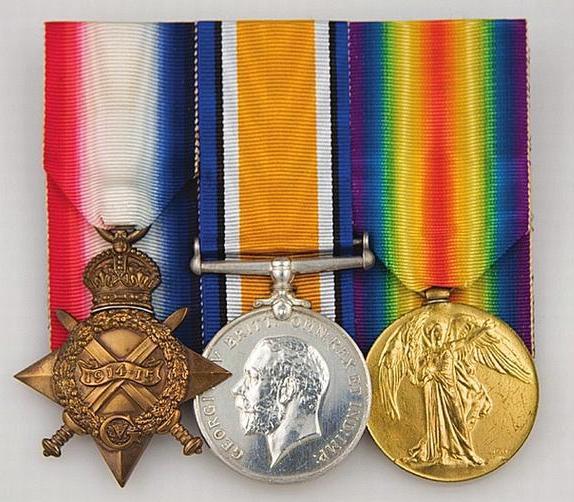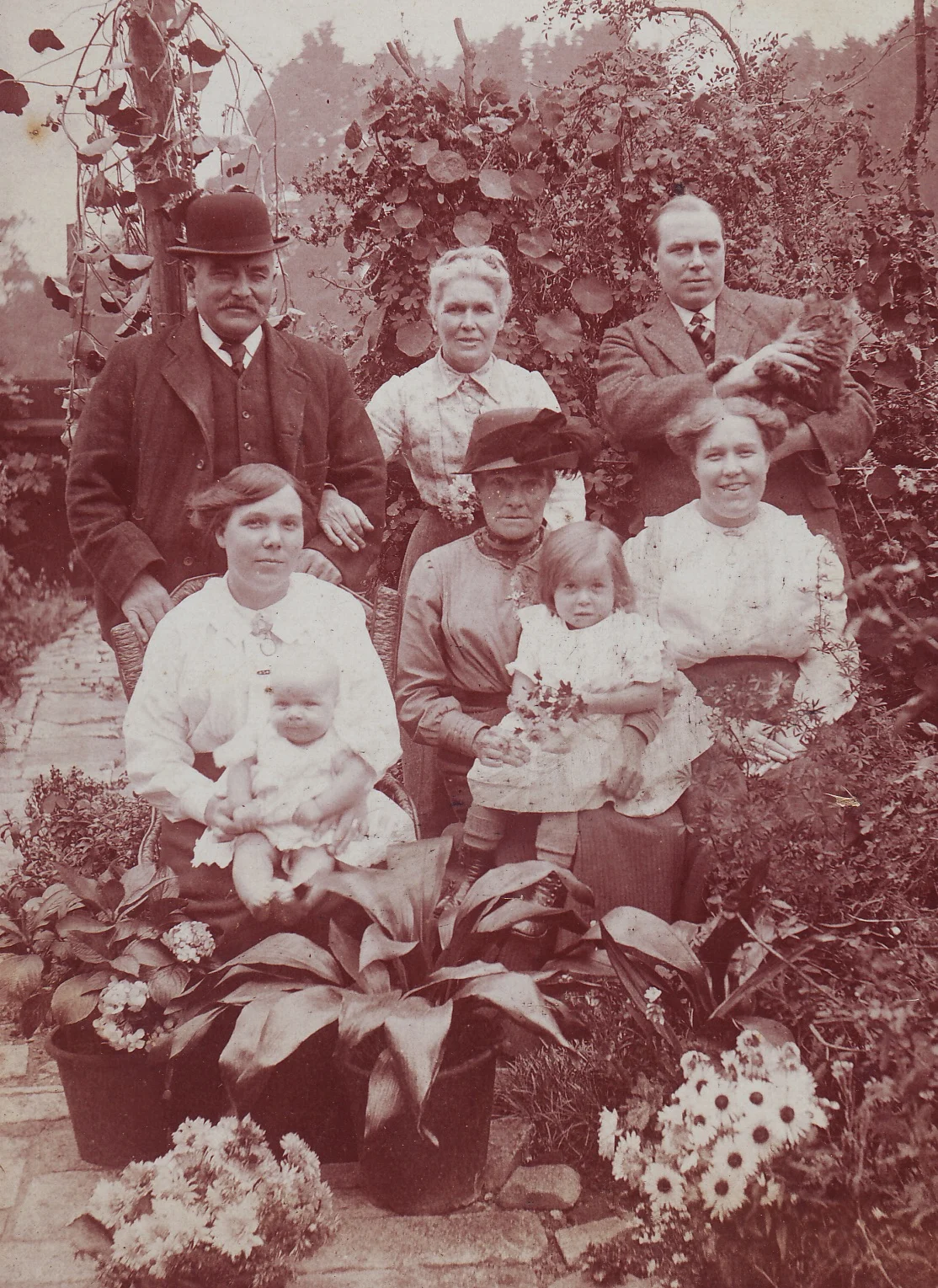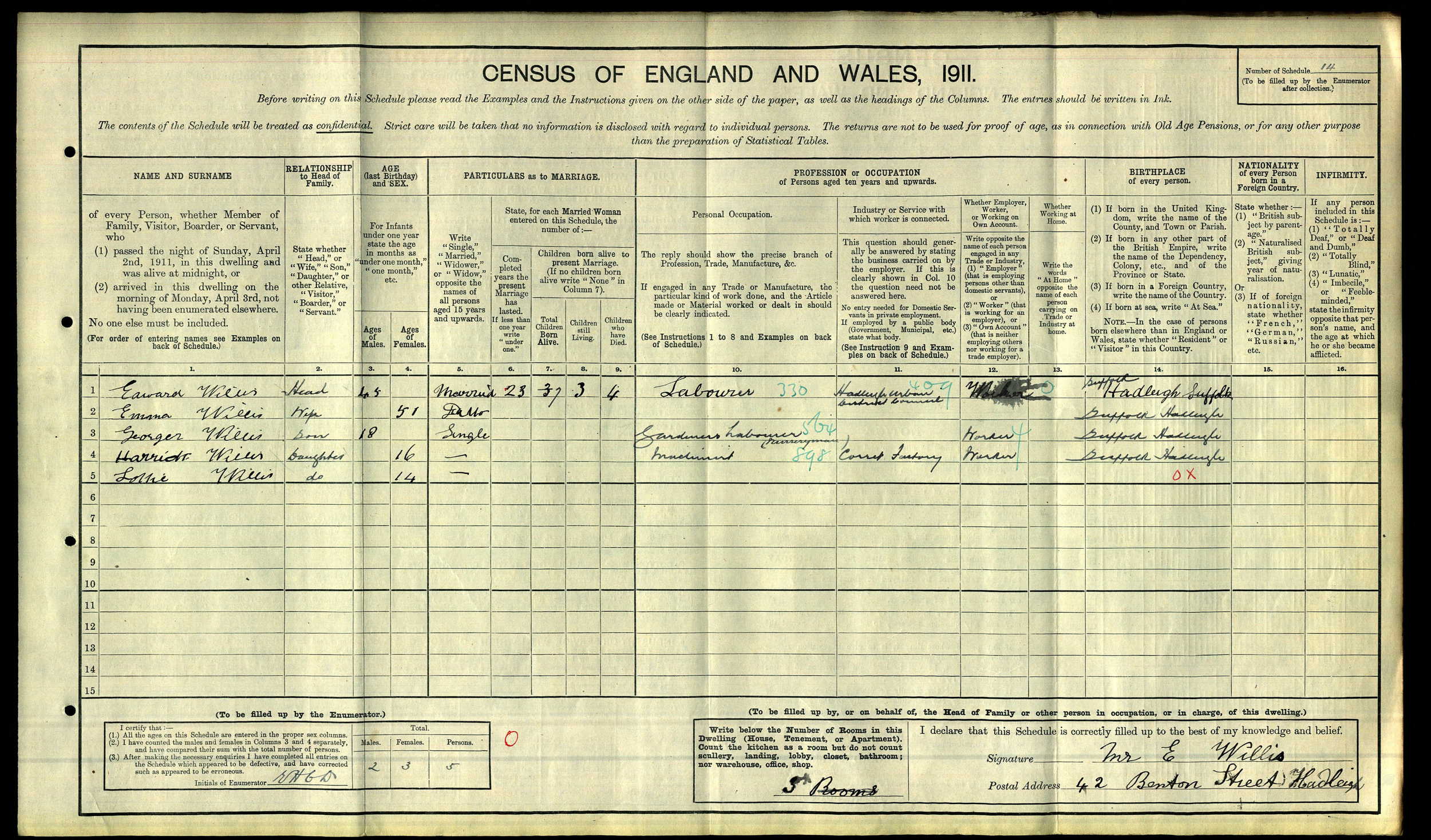George Edward Willis
Rank: Private
Service Number: 1808
Date of Birth: 1893
Regiment: A Coy, 1/5th Suffolk Regiment
Date of Death: 12 August 1915
Age at death: 22
Cemetery / Memorial: Helles Memorial, Gallipoli
Country: Turkey
Grave / Reference: Panel 46 and 47
Relatives: Son of the late Edward Henry and Emma Wills
Address: 58 Benton Street, Hadleigh
The whereabouts of Private Willis' medals is not known. However, he would have been entitled to the above three medals.
Private George Edward Willis
George Edward was born in Benton Street, Hadleigh, in November 1892, to Edward and Emma Willis. He had two sisters, Harriet born 1894 and Emily Lottie born 1897 (in photo below).
Family photograph c.1915 - Top left, Father Edward Henry Willis, Aunt Honour & Half-brother Alfred Cook Green. Bottom left, sister Harriet Emma Eliza, mother Emma & sister Emily Lottie. Baby nephew William Sydney & niece Olive Emma.
The census of 1911 records 18 year old George's occupation as a gardener's labourer-nurseryman and reveals the sad fact that his mother Emma had given birth to 4 babies which had not survived. So as any mother can only imagine, waving goodbye to her only surviving son as he went off to war must have been especially difficult.
George's sister Harriet married William Warren who, like George is also missing from the family photo as at the age of 26 was also serving in the war, but happily survived. They had a total of 6 children, but Harriet died aged only 45, leaving the youngest child, 4 year old Joan, to be brought up by her eldest sister Olive in Hadleigh.
We are not sure exactly when George enlisted in the army, but it seems like many other young men from Hadleigh, he joined the local territorial battalion, the 5th Suffolk Regiment. If we assume that he had joined the battalion before war broke out then we know that he would have been mobilised on the night of the 4th/5th August 1914. The battalion then spent a number of months carrying out home service tasks. Once it became apparent that more troops would be needed for overseas service, the men of the battalion were asked to volunteer. After giving this some serious thought, 72% of the men volunteered and the battalion was redesigned 1st/5th Suffolk Regiment. Those who opted to stay on home service duties only, became the 2nd/5th.
The 1st/5th Suffolks completed their training and preparation and were re-equipped for service in the eastern theatre. They embarked along with the rest of 163 Brigade and the 54 Eastern Division at the end of July from Liverpool bound for Gallipoli.
1911 Census
Medal rolls
The 1st/5th Suffolks completed their training and preparation and were re-equipped for service in the eastern theatre. They embarked along with the rest of 163 Brigade and the 54 Eastern Division at the end of July from Liverpool bound for Gallipoli. They arrived and went ashore at Suvla Bay on 10th August 1915 and were quickly moved forward and by midday on the 12th were manning the forward trenches on the Anafarta Plain. At 4pm they were ordered forward as part of a 163 Brigade operation to clear the Plain of snipers in preparation for a much larger Divisional operation that was planned for the following day. The battalion was on the left of the brigade line and 'A' Company made up of Hadleigh men were in the first wave. There was at least 75 Hadleigh men involved and this was a true baptism of fire. They were told it would be a straight forward advance to mop up the odd sniper, but in reality they faced a determined and ruthless enemy. The enemies intimate knowledge of the ground was key. They sniped the Suffolks who could not see the firing points and even if they could, they had no artillery support to combat the snipers. In addition, the Turks made best use of their own artillery, specifically using shrapnel shells, which ultimately halted the Brigades advance. The Suffolks fell back to a shallow river bed / ditch where they formed the new front line. A few days later they were relieved and returned to the reserve trenches where they discovered that the attack had cost them dearly; 11 Officers and 178 Other Ranks were killed, wounded or missing. Although official records suggest that many of the Suffolks went missing on or after the 21st Aug, we now believe that they were actually lost during the advance on the 12th.
Landing beach at Suvla Bay (photo taken in 2014)
Helles Memorial
On that day, at least 16 men from Hadleigh were killed. Due to the nature of the fighting, their bodies were never recovered from the battlefield until the early 1920s. By then the remains were unrecognisable and could not be identified. The remains were most likely buried in the Azmak Commonwealth War Grave Commission cemetery in an unmarked grave. This cemetery is in the area were the Suffolks held the front line. Their names are commemorated on the impressive Helles Memorial which stands on the southern tip of the Gallipoli peninsular.
AMZAK cemetery
The 1/5th Suffolks remained on the Gallipoli peninsula until the campaign was abandoned and the troops evacuated in late 1915.
Name on Helles Memorial


















